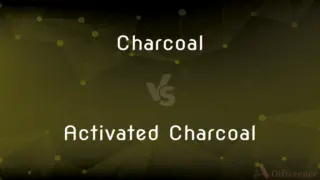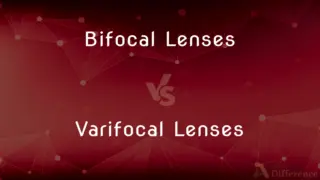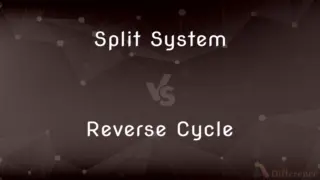Schwann Cell vs. Myelin Sheath — What's the Difference?
By Tayyaba Rehman — Published on October 25, 2023
Schwann cells are glial cells that produce the myelin sheath. The myelin sheath is an insulating layer around nerve fibers, enhancing signal speed. Both play critical roles in nerve function.

Difference Between Schwann Cell and Myelin Sheath
Table of Contents
ADVERTISEMENT
Key Differences
Schwann Cell: Schwann cells are a type of glial cell found primarily in the peripheral nervous system. They serve various roles, including supporting neurons and aiding in nerve regeneration. However, one of the most crucial functions of the Schwann cell is the production of the myelin sheath. The myelin sheath, on the other hand, is the product and not the producer.
Myelin Sheath: Surrounding the axons of many neurons, the myelin sheath acts as an insulator. This insulating property accelerates the transmission of electrical signals or action potentials down the neuron, facilitating efficient communication within the nervous system. While the myelin sheath provides this essential function, it owes its existence to the Schwann cells, which create it.
Formation and Regeneration: Schwann cells wrap around axons, layering their membranes to form the myelin sheath. In the event of nerve damage, Schwann cells play a pivotal role in guiding regrowth and regeneration, something the myelin sheath itself doesn't do.
Functional Differences: While both the Schwann cell and the myelin sheath are intrinsically linked, they have distinct roles. Schwann cells support, nourish, and produce the myelin sheath. The myelin sheath, in turn, is tasked with insulating axons and facilitating rapid signal transmission.
Relation and Dependency: Schwann cells and the myelin sheath share a symbiotic relationship. Without Schwann cells, the myelin sheath wouldn't exist. Conversely, without the myelin sheath, nerve signal transmission would be much slower, showcasing the importance of the product of Schwann cells.
ADVERTISEMENT
Comparison Chart
Nature
Type of glial cell
Insulating layer around axons
Function
Produce myelin, support neurons, aid regeneration
Insulate axons, speed up signal transmission
Location
Peripheral nervous system
Around axons in both central and peripheral nervous systems
Dependency
Independent cell
Product of Schwann cells and oligodendrocytes
Role in Damage
Aids in nerve regeneration
Does not regenerate; needs Schwann cells for reconstruction
Compare with Definitions
Schwann Cell
Involved in rapid signal transmission due to myelination.
By producing the myelin sheath, the Schwann cell ensures efficient nerve signaling.
Myelin Sheath
An insulating layer around neuron axons.
The myelin sheath accelerates the transmission of electrical signals in the neuron.
Schwann Cell
A glial cell of the peripheral nervous system.
The Schwann cell wraps around the neuron's axon, providing support and protection.
Myelin Sheath
Enhances the speed of nerve signal transmission.
Neurons with a myelin sheath can transmit signals much faster than unmyelinated ones.
Schwann Cell
Produces the myelin sheath around axons.
Without the Schwann cell, many axons would lack their insulating myelin layer.
Myelin Sheath
Composed of lipid-rich layers.
The composition of the myelin sheath allows it to effectively insulate the axon.
Schwann Cell
Essential for neuronal support and nourishment.
Neurons in the peripheral nervous system rely on the Schwann cell for sustenance and care.
Myelin Sheath
A critical component for efficient nervous system function.
Impairment of the myelin sheath can lead to neurological disorders.
Schwann Cell
Aids in nerve regeneration after injury.
After nerve damage, the Schwann cell facilitates the axon's repair process.
Myelin Sheath
Produced by Schwann cells in the peripheral nervous system.
Thanks to the Schwann cell, the axon has a protective myelin sheath.
Common Curiosities
Where is the myelin sheath found?
The myelin sheath surrounds axons in both the central and peripheral nervous systems.
What happens if the myelin sheath is damaged?
Damage to the myelin sheath can lead to neurological disorders, such as multiple sclerosis.
Are Schwann cells the only cells that produce myelin?
No, in the central nervous system, oligodendrocytes produce myelin.
What's the relationship between Schwann cells and the myelin sheath?
Schwann cells produce and maintain the myelin sheath around axons in the peripheral nervous system.
What's the primary function of the Schwann cell?
The Schwann cell produces the myelin sheath and supports neurons in the peripheral nervous system.
Can the myelin sheath regenerate?
With the help of Schwann cells, myelin can be reconstructed after damage, especially in the peripheral nervous system.
What does the myelin sheath do?
The myelin sheath insulates neuron axons, enhancing the speed of nerve signal transmission.
Can nerves regenerate without Schwann cells?
Schwann cells play a pivotal role in nerve regeneration, making them essential for repair after injury.
Do all axons have a myelin sheath?
No, not all axons are myelinated. Some remain unmyelinated.
How does the Schwann cell aid in nerve repair?
Schwann cells guide regrowth and regeneration after nerve damage.
What might happen if Schwann cells malfunction?
Malfunctioning Schwann cells could lead to demyelination or hinder nerve regeneration.
Is the structure of the myelin sheath the same in the central and peripheral nervous systems?
While the function is similar, the myelin sheath's structure and producing cells (oligodendrocytes vs. Schwann cells) differ between the two systems.
Why is the myelin sheath important for nerve function?
The myelin sheath allows for faster signal transmission, ensuring efficient communication within the nervous system.
How do Schwann cells produce the myelin sheath?
Schwann cells wrap their membranes around axons, layering to form the myelin sheath.
Is the myelin sheath continuous along the axon?
No, there are gaps known as nodes of Ranvier between myelinated sections.
Share Your Discovery

Previous Comparison
Convolvulaceae vs. Solanaceae
Next Comparison
Job Analysis vs. Job DescriptionAuthor Spotlight
Written by
Tayyaba RehmanTayyaba Rehman is a distinguished writer, currently serving as a primary contributor to askdifference.com. As a researcher in semantics and etymology, Tayyaba's passion for the complexity of languages and their distinctions has found a perfect home on the platform. Tayyaba delves into the intricacies of language, distinguishing between commonly confused words and phrases, thereby providing clarity for readers worldwide.














































